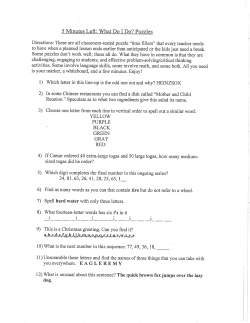
Document 95879
EXPERIMENT 10: Soap Swirls Challenge: See how water moves—go with the flow! WHAT YOU NEED: • Clear plastic bottle or jar with a tight-fitting, screw-on cap or lid (A clear plastic water bottle, especially one with ridges, works great) • Liquid hand soap that has glycol stearate in it (The brand we used is Colgate-Palmolive’s Softsoap®, but any brand of liquid soap with “glycol stearate”—not “glycol distearate”— will work; check the ingredients on the label.) • Water • Food coloring • Clear tape Screw the cap on the bottle. Turn the bottle upside-down a few times to mix the soap and water. If you get foam, take the cap off and trickle some more water into the bottle. The foam will run over the edge. Recap the bottle tightly. 3. 5. Twirl the bottle slowly. What do you see? What happens when you stop twirling the bottle? What happens if you spin it quickly? STEP-BY-STEP: Fill the bottle or jar about 1/4 full with liquid soap. Add a drop or two of food coloring. The coloring will make the swirls easier to see. 1. Turn on your faucet so you have just a trickle of water. Use that to fill up the rest of the bottle. (If you run the water too hard, you’ll get foam.) Make sure that the water fills the bottle all the way to the very top. 2. 4. 6. Dry the bottle and the cap, then wrap clear tape around it so the bottle won’t leak. Try shaking the bottle up and down or side to side. What different patterns do you see inside the bottle? For more fun and conservation-related experiments, please visit www.plumbingexcellence.org EXPERIMENT 10: Soap Swirls Challenge: See how water moves—go with the flow! 7. If the liquid inside the bottle looks like it’s all one solid color, just twirl or shake it again to make more patterns. If the cap on the bottle is sealed, Go with the Flow can last for years. QUESTIONS: ? • What kind of patterns do you see in your bottle? What do you see when you turn the bottle slowly? Do you see smooth streaks in the water? When layers of water are moving slowly and smoothly past each other, you get this pattern, which scientists call laminar flow. • What happens when you suddenly stop turning the bottle? What happens when you turn it very fast? Do you see lots of swirls and wavy patterns? When one layer of water moves rapidly past another layer of water, it causes turbulence, which you see as swirly patterns.
© Copyright 2025





















